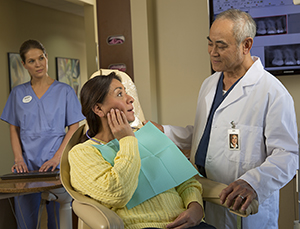Injury (trauma) to the teeth or mouth can happen from an accident or sports injury. Dental trauma may not always seem serious. But even minor injuries can cause infection or other problems. The key to saving your smile is getting help right away.
When to go to the emergency room (ER)
Speed is vital when it comes to most tooth trauma. The faster you're treated, the better the chances your tooth or teeth can be saved. Go to your dentist or the ER right away if:
-
You break 1 or more teeth.
-
You have 1 or more teeth knocked out.
-
A cut on your lip or tongue won't stop bleeding.
-
Your teeth don't fit together correctly when you bite down after an injury.
-
You have trouble opening or closing your jaw
What to do if your tooth is knocked out
If a permanent tooth is knocked out:
-
Handle the tooth by the top (the crown, or chewing surface), not the roots.
-
Keep the tooth moist at all times. If you can, put the tooth back in the socket in your mouth. Or put it in a glass of milk. Or place it in a tooth preservation product that has an American Dental Association (ADA) Seal of Acceptance. This keeps the tooth from drying out. Don't put the tooth in tap water. It can damage the tooth root cells.
-
Get medical help right away at the dentist or ER.
What to expect in the ER
Your injury will be examined. If you've lost a tooth, a dentist may be able to replant it. For the best results, this is done within 1 hour after your injury. In many cases, a broken tooth can also be repaired. Cuts and scrapes (abrasions) may be treated with cold packs and dressings. An X-ray will likely be taken to check on the extent of the damage and rule out any fracture of the roots of your teeth.
When to call your healthcare provider
Once you're home, call your dentist right away if you:
-
Have a fever of
100.4 ° F (38 °C) or higher, or as advised by your dentist -
Have drainage from around a repaired tooth
-
Have pain that gets worse after 24 hours
-
Have continued bleeding


